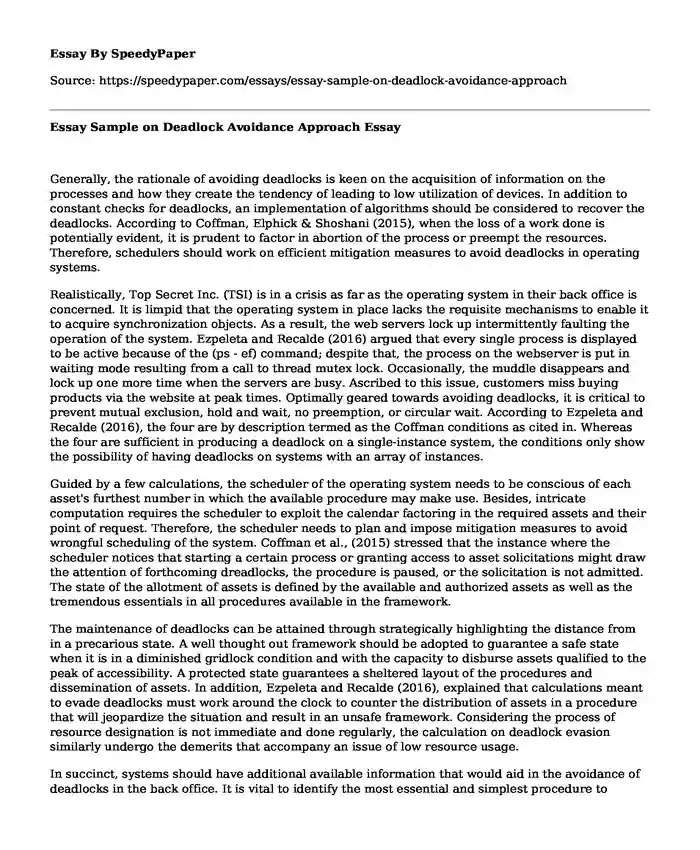
| Type of paper: | Essay |
| Categories: | Computer science |
| Pages: | 3 |
| Wordcount: | 676 words |
Generally, the rationale of avoiding deadlocks is keen on the acquisition of information on the processes and how they create the tendency of leading to low utilization of devices. In addition to constant checks for deadlocks, an implementation of algorithms should be considered to recover the deadlocks. According to Coffman, Elphick & Shoshani (2015), when the loss of a work done is potentially evident, it is prudent to factor in abortion of the process or preempt the resources. Therefore, schedulers should work on efficient mitigation measures to avoid deadlocks in operating systems.
Realistically, Top Secret Inc. (TSI) is in a crisis as far as the operating system in their back office is concerned. It is limpid that the operating system in place lacks the requisite mechanisms to enable it to acquire synchronization objects. As a result, the web servers lock up intermittently faulting the operation of the system. Ezpeleta and Recalde (2016) argued that every single process is displayed to be active because of the (ps - ef) command; despite that, the process on the webserver is put in waiting mode resulting from a call to thread mutex lock. Occasionally, the muddle disappears and lock up one more time when the servers are busy. Ascribed to this issue, customers miss buying products via the website at peak times. Optimally geared towards avoiding deadlocks, it is critical to prevent mutual exclusion, hold and wait, no preemption, or circular wait. According to Ezpeleta and Recalde (2016), the four are by description termed as the Coffman conditions as cited in. Whereas the four are sufficient in producing a deadlock on a single-instance system, the conditions only show the possibility of having deadlocks on systems with an array of instances.
Guided by a few calculations, the scheduler of the operating system needs to be conscious of each asset's furthest number in which the available procedure may make use. Besides, intricate computation requires the scheduler to exploit the calendar factoring in the required assets and their point of request. Therefore, the scheduler needs to plan and impose mitigation measures to avoid wrongful scheduling of the system. Coffman et al., (2015) stressed that the instance where the scheduler notices that starting a certain process or granting access to asset solicitations might draw the attention of forthcoming dreadlocks, the procedure is paused, or the solicitation is not admitted. The state of the allotment of assets is defined by the available and authorized assets as well as the tremendous essentials in all procedures available in the framework.
The maintenance of deadlocks can be attained through strategically highlighting the distance from in a precarious state. A well thought out framework should be adopted to guarantee a safe state when it is in a diminished gridlock condition and with the capacity to disburse assets qualified to the peak of accessibility. A protected state guarantees a sheltered layout of the procedures and dissemination of assets. In addition, Ezpeleta and Recalde (2016), explained that calculations meant to evade deadlocks must work around the clock to counter the distribution of assets in a procedure that will jeopardize the situation and result in an unsafe framework. Considering the process of resource designation is not immediate and done regularly, the calculation on deadlock evasion similarly undergo the demerits that accompany an issue of low resource usage.
In succinct, systems should have additional available information that would aid in the avoidance of deadlocks in the back office. It is vital to identify the most essential and simplest procedure to outline the limit of each available resource. Dynamically, the avoidance algorithm puts on a clear examination of the state of the resource allocation hence deterring the circular-wait condition. The allocation of the resources is determined by the resources present and under allocation in addition to the processes’ extreme demands.
References
Coffman, E. G., Elphick, M., & Shoshani, A. (2015). System deadlocks. ACM Computing Surveys (CSUR), 3(2), 67-78.
Ezpeleta, J., & Recalde, L. (2016). A deadlock avoidance approach for nonsequential resource allocation systems. IEEE Transactions on Systems, Man, and Cybernetics-Part A: Systems and Humans, 34(1), 93-101.
Cite this page
Essay Sample on Deadlock Avoidance Approach. (2023, Oct 31). Retrieved from https://speedypaper.net/essays/essay-sample-on-deadlock-avoidance-approach
Request Removal
If you are the original author of this essay and no longer wish to have it published on the SpeedyPaper website, please click below to request its removal:
- IT Admission Essay Sample
- Free Essay on the Paperless Debate
- Is Internet and Technology Changing the Way We Live? Essay Sample
- Comparison between ArcGIS and MapInfo Software - Essay Example
- Free Essay: The Unified Theory of Acceptance and Use Theory (UTAUT)
- AI Regulation, Cybersecurity, Superintelligence: Issues with AI Dev - Essay Sample
- Smartphone Usage in Children - Essay Sample
Popular categories




